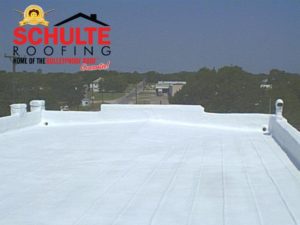One of the most common types of roofing systems used for commercial buildings is what’s known as a low-sloped or a flat roof. The horizontal roof design is popular with Houston commercial roofing as it allows efficient utilization of space and costs less due to the fact that horizontal roofs are easier to install.
design is popular with Houston commercial roofing as it allows efficient utilization of space and costs less due to the fact that horizontal roofs are easier to install.
Some of the most common types of roofing materials used for commercial flat roofs are: BUR; Modified Bitumen; metal; and synthetic materials such as CPE, EPDM, Hypalon, TPO, PVC, and CPA to name a few. Such roofing materials have an average life span of 10 to 15 years with an exception with metal that can last up to 25 or more years.
Common Commercial Roof Problems
The majority of the roofing material used for flat roof systems is highly reactive to UV rays and sudden temperature changes. Constant exposure to sunlight causes the material to become brittle; weakening of the material over time creates a fissure on it that causes water to seep into the roof’s underlying structure. During winter, flat roofs are also prone to ice damming because there is no slope to effectively drain the melted snow. If the water sits on top of the roof for too long, that water will eventually seep through or damage the material.
Regular Roof Inspections
Keeping a roof healthy is primarily reliant upon conducting regular inspections to check for any signs of deterioration. It is advisable to perform these necessary inspections from semi-annually to at least every 2 years to monitor for any damage that might be occurring.
When inspecting the roof, look for signs of brittleness and cracking especially if the roofing material is made from asphalt, modified bitumen or synthetic material such as PVC. These types of materials are very sensitive to UV rays that cause it to become brittle. If the roof is installed in a hot or tropical climate, monitor for any signs of excessive weathering.
During inspection, be sure to check the drains and gutters to make sure they are clear of debris that might disrupt rain water flow. Inspect the flashings and sealants as well as any caulking. These roofing elements readily turn brittle over time and will require regular maintenance work to prevent leaks.
Aside from focusing on the roof top, it is also important to inspect the underside of the roof regularly. Any leak would be much more visible on the underlying structure of the roof. Look for any darkening or dampening on the roof’s underside structure, as it signals a leak in the roof. Look for stains on the ceiling that could indicate a leak in the roof.
Roof Maintenance
Aside from performing regular inspections, it is also important to do regular roof maintenance to get the most out of a roof’s service life. For most types of Houston commercial roofing, maintenance items include removing snow during winter to prevent damming. If the roof is located underneath a tree branch, it is important to regularly remove fallen leaves since deteriorating organic material on the roof can cause the roofing material to degrade even faster. It is also important to regulate access to the roof. The more people on the roof, the more the roof is prone to damage from foot traffic.
For metal roofs, regular maintenance is important to get the most out of its service life. Although metal roofs are known to last up to 25 years, regular maintenance is required to achieve this life span. Maintaining a metal roof is as simple as reapplying a protective layer of paint once the existing paint layer begins to chip off.
Safety Reminder
When doing roof maintenance and inspection, always think first of safety, as there is always the potential risk of falling while on a roof. When doing an inspection, have someone serve as a look-out in case emergency help is needed. Wear a good pair of shoes that can provide a sufficient amount of traction. If uneasy about roof climbing, don’t do it. Call a professional Houston commercial roofing company and have the roof inspected, maintained, and repaired by them. Then your roofing system can indeed survive all that Mother Nature throws its way – with your help!
